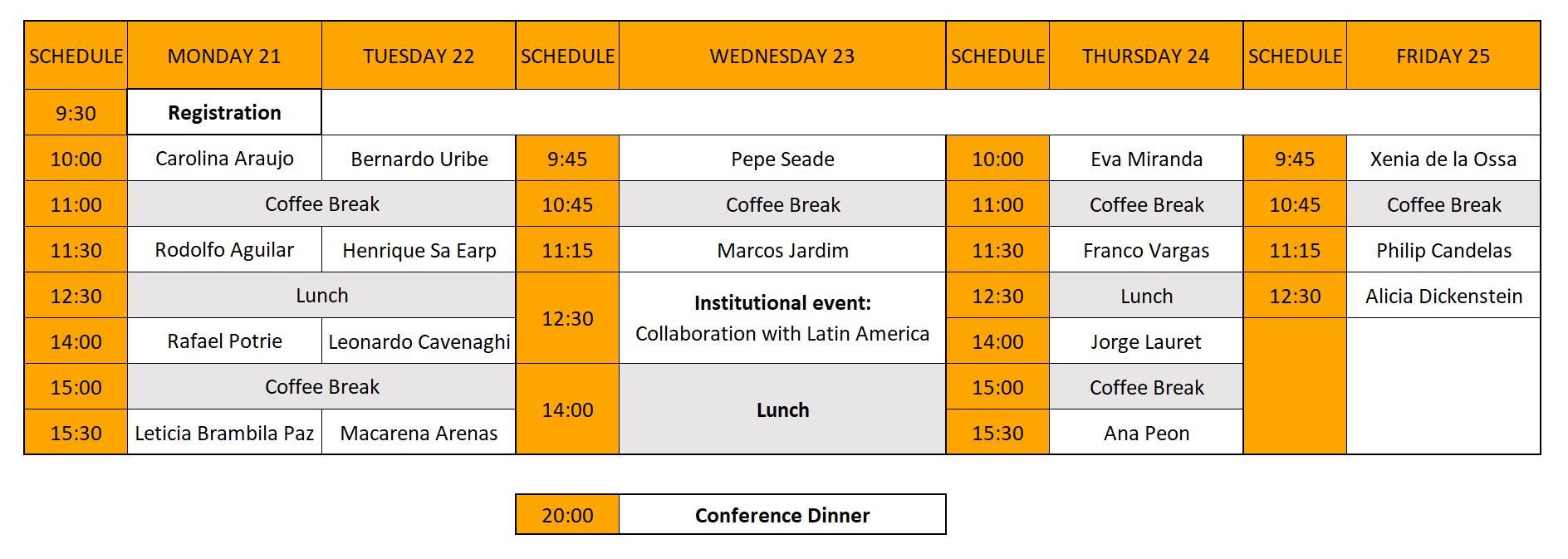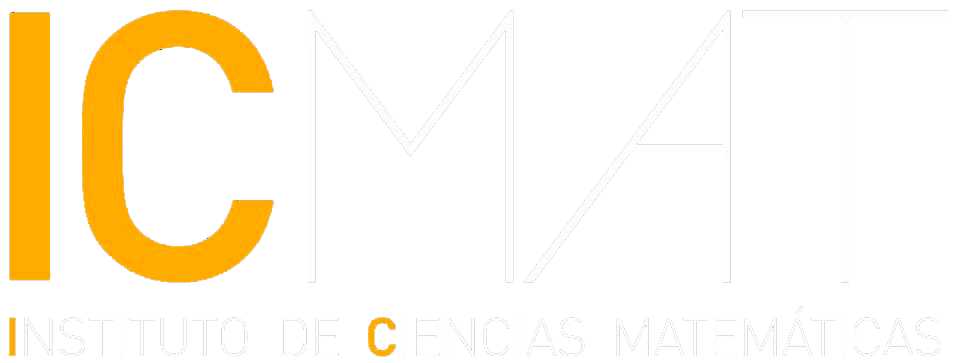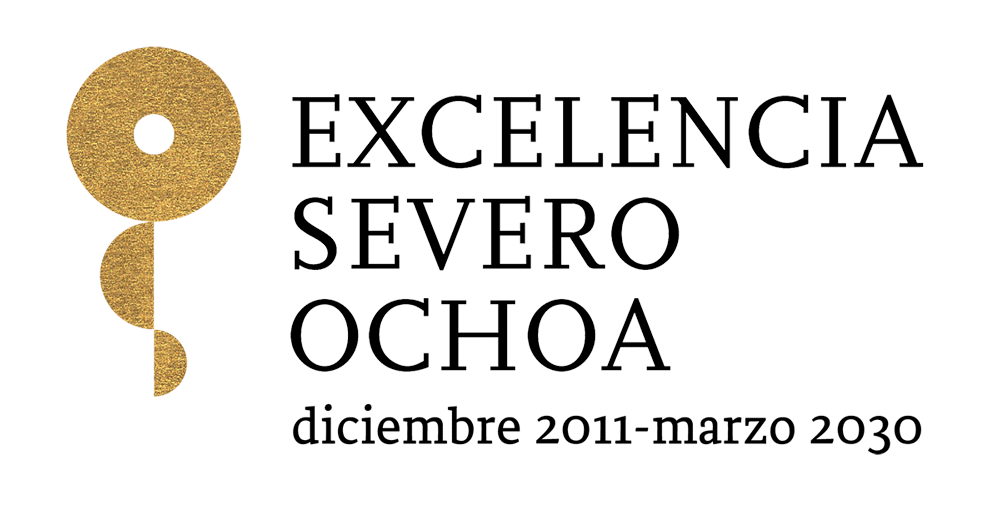Programme

More information about the Institutional event, click here
Titles & Abstracts:
Carolina Araujo (IMPA, Brazil): The Calabi problem for Fano 3-folds.
Abstract: In his 1954 ICM lecture, Eugenio Calabi popularized a formidable problem in the confluence of differential geometry and algebraic geometry, which became known as the "Calabi problem". The problem asks which compact complex manifolds admit a certain metric with constant curvature, called "Kähler-Einstein metric". A necessary condition for the existence of a Kähler-Einstein metric is that the canonical class of the manifold has a definite sign. For manifolds with zero or positive canonical class, the Calabi problem was solved by Yau and Aubin/Yau in the 1970s. They confirmed Calabi’s prediction, showing that these manifolds always admit a Kähler-Einstein metric. On the other hand, projective manifolds with negative canonical class, known as “Fano manifoldsâ€, may or may not admit a Kähler-Einstein metric. In the last decade, surprising and deep connections between the existence of Kähler-Einstein metrics and birational geometry have been revealed, producing important advances in the Calabi problem. In this talk, I will discuss the Calabi problem, its connections with birational geometry, and the current state of the art in dimension 3.
Rodolfo Aguilar (IMSA, USA): Calabi-Yau vs log Calabi-Yau threefolds.
Abstract: We will compare the Hodge theory and the geometry of smooth projective Calabi-Yau threefolds against quasi-projective threefolds obtained by removing a smooth anti-canonical K3 surface to a smooth projective Fano threefold. Focus will be centered around Yukawa cubics, curves and Abel-Jacobi maps. Joint work with Ph. Griffiths and M. Green.
Rafael Potrie (UdelaR, Uruguay): Transverse foliations in 3-manifolds and applications to partially hyperbolic dynamics.
Abstract: In recent work with S. Fenley and others we have started a systematic study of transverse pairs of foliations in 3-manifolds without compact leaves in the hope of obtaining geometric properties of the foliation obtained by intersecting the foliations. The problem is motivated by the topological classification of partially hyperbolic diffeomorphisms in 3-manifolds but also interacts with other problems appearing in some nearby subjects. I will try to present the problem, explain the way in which it helps to classify smooth dynamics and propose some possible questions that may be approachable with our techniques.
Leticia Brambila Paz (CIMAT, Mexico): Twisted Brill-Noether Theory.
Abstract: The classical Brill-Noether theory for linear bundles has been studied since the 19th century. Last century it was formalized and formal proofs were given, with results for general curves, Petri curves, some special curves and any curve. For higher range bundles it has been shown that the corresponding theory is not a simple generalization of the classical theory. In this talk I will present results related to the Twisted Brill-Noether theory and its applications to different problems like moduli of unstables, Butler´s conjecture, stability of the generalized Picard bundle, etc.
Bernardo Uribe (Barranquilla, Colombia): Magnetic Equivariant K-theory
Abstrat: We present the fundamental properties of the K-theory groups of complex vector bundles endowed with actions of magnetic groups. These magnetic equivariant K-theory groups are relevant in condensed matter physics since they provide topological invariants of gapped Hamiltonians in magnetic crystals.
Henrique Sa Earp (Campinas, Brazil): Updates on flows of geometric structures
Abstract: I will recall some results towards a general theory for flows of H-structures, obtained with Fadel, Loubeau and Moreno. Then I will present some recent results on SU(2)-flows on 4-manifolds, initiating a classification programme of `parabolic’ flows, based on a representation-theoretic method originally due to Bryant in the context of G2 geometry, obtained with Fowdar.
Leonardo Cavenaghi (Miami, USA): G-equivariant atoms.
Abstract: In this talk, we introduce the concept of atoms developed by Katzarkov- Kontsevich-Pantev-Yu while presenting some generalizations, particularly in the G-equivalent context. We will discuss applications related to questions in G-equivariant birational geometry and, time permitting, the development of the theory to the orbifold context. This is based on two joint works (in progress) with Lino Grama, Ludmil Katzarkov, and Maxim Kontsevich.
Macarena Arenas (Cambridge, UK): Taut smoothings and shortest geodesics.
Abstract: In this talk we will discuss the connection between combinatorial properties of minimally self-intersecting curves on a surface S and the geometric behaviour of geodesics on S when S is endowed with a Riemannian metric. In particular, we will explain the interplay between a smoothing, which is a type of surgery on a curve that resolves a self-intersection, and k-systoles, which are shortest geodesics having at least k self-intersections, and we will present some results that partially elucidate this interplay.
Jose Seade (UNAM, Mexico): On the topology of the local Milnor fibers of functions on singular varieties.
Abstract: Let (X,p) be the germ at 0 in C^N of a complex analytic singular variety of pure dimension n, with a possibly non-isolated singularity at 0, and let f from (X,p) to (C,0) be a
holomorphic map-germ with a singular point at 0 with respect to some Whitney stratification. Work
of Hironaka implies that taking the germ (X,p) small enough, we can assume that 0 is the only
critical value and f is a Thom map. By Milnor-Lê, one has that the nearby local fibers f^{-1}(t)
\cap B_r form a fiber bundle over a punctured neighborhood of 0. The fiber F_f of this bundle is
called the Milnor fiber of f.
In this talk we discuss how to build up F_f up to homeomorphism out from its intersection with a
generic slice by a linear function.
This is joint work with Lê Dūng Tráng and Juan José Nuño Ballesteros.
Marcos Jardim (Campinas, Brazil): Higher rank DT/PT wall-crossing in Bridgeland stability.
Abstract: We prove that the Gieseker moduli space of stable sheaves on a smooth
projective threefold X of Picard rank 1 is separated from the moduli space of PT
stable objects by a single wall in the space of Bridgeland stability conditions on X,
thus realizing the higher rank DT/PT correspondence as a wall-crossing phenomenon
in the space of Bridgeland stability conditions. In addition, we also show that only
finitely many walls pass through the upper (\beta,\alpha)-plane parametrizing
geometric Bridgeland stability conditions on X which destabilize Gieseker stable
sheaves, PT stable objects or their duals when \alpha>\alpha_0.
Version with no latex code: We prove that the Gieseker moduli space of stable
sheaves on a smooth projective threefold X of Picard rank 1 is separated from the
moduli space of PT stable objects by a single wall in the space of Bridgeland stability
conditions on X, thus realizing the higher rank DT/PT correspondence as a wall-
crossing phenomenon in the space of Bridgeland stability conditions. In addition, we
also show that only finitely many walls pass through the upper half-plane
parametrizing geometric Bridgeland stability conditions on X which destabilize
Gieseker stable sheaves, PT stable objects or their duals when the vertical
parameter is sufficiently large.
Eva Miranda (Barcelona, Spain): The Log and the b: Symplectic Geometry at the Poisson Frontier.
Abstract: Drawing on examples from pseudo-Riemannian geometry, celestial mechanics, Painlevé equations, and deformation quantization, I will explore and compare several classes of singular symplectic manifolds, such as b- (or log-) symplectic and folded symplectic manifolds. This framework sets the stage for addressing exciting open challenges, including the formulation of a symplectic topology programme for Poisson manifolds.
Franco Vargas Pallete (IHES, France): Epstein curves and the holography of the Schwarzian action.
Abstract: In this talk we will construct geometric interprations of the Schwarzian action of a circle diffeomorphism in terms of the geometry of its associated Epstein curve in the hyperbolic plane. Through these interpretations we will derive geometric proofs for the non-negativity of the action. Based on joint work with Yilin Wang and Catherine Wolfram.
Jorge Lauret (Córdoba, Argentina): Homogeneous Hermitian manifolds revisited.
Abstract: Starting from a flag manifold F=G/H (the only compact homogeneous
manifolds which are Kähler), each of the countable many closed tori T in
the center Z(H) of even codimension defines a torus bundle M=G/K over F
with fibre A=Z(H)/T, where K=[H,H]xT. The different slopes of T in Z(H)
may or may not have topological consequences on M. These so-called
C-spaces M=G/K are precisely the compact homogeneous spaces
admitting invariant complex structures, which are all given by one of the
finitely many complex structures on F and any left-invariant complex
structure on the torus A, i.e., any linear map J_a on the Lie algebra a of A
whose square is -I.
The freedom to choose J_a is overwhelming. In this talk, we will show that
the existence of distinguished Hermitian metrics like Hermite-Einstein,
balanced, SKT, CYT, Chern-Einstein, etc., can be very sensitive to such a
choice.
Ana Peon (Santiago, Spain): Semi-polarised integrable system via framed Higgs bundles.
Abstract: Framings of bundles have been recurrently used as tools to, e.g., rigidify moduli problems or study their Poisson geometry. In this talk, I will explain new examples of semi-polarised integrable systems arising from moduli spaces of framed Higgs bundles.
Xenia de la Ossa (Oxford, UK): Modularity of Calabi-Yau varieties I: periods and counting points over finite fields.
Abstract: Calabi-Yau varieties have taken a prime role in physics and string theory. Their topology and geometry, and that of their moduli spaces, determine to a large extent the physics of a compactification of a 10 dimensional theory on the Calabi-Yau variety. It turns out that the arithmetic structure of these varieties also plays a crucial role in physics. For example it has an impact in black hole physics and the structure of scattering amplitudes. I will begin by motivating the study of the arithmetic structure of these varieties. I will explain how counting points over a finite field yields an expression explicitly in terms of the periods of the holomorphic three form of a Calabi-Yau threefold. I will illustrate this using one parameter families of Calabi-Yau manifolds and show how our expressions also involve p-adic zeta values. (The original parts of the talk is work in progress with P Candelas and Eleonora Svanberg.)
Philip Candelas (Oxford, UK): Modularity of Calabi-Yau manifolds II: L-functions and modularity for families of Calabi-Yau Manifolds.
Abstract: The local zeta functions of a Calabi-Yau manifold are gathered together into a global L-function. These L-functions are conjectured to have modular properties and to satisfy functional equations. I will review evidence that supports this in the context of 1-parameter families of Calabi-Yau varieties, as well as the calculation of the conductors for these families and the data structures that describe the L - functions as functions of the parameter. (This is work in progress with X de la Ossa, N Gegelia and D van Straten.)
Ernesto Lupercio (Cinvestav, Mexico): From Complex Systems to Complex Manifolds.
Abstract: In this talk, I will provide an overview of recent research inspired by Complex Systems in mathematical physics. This line of inquiry investigates the geometry of convex sets, revealing new insights into the Hodge theory for complex manifolds, including cases that may not satisfy the Kähler condition. These findings are drawn from collaborative efforts with (1) Kalinin, Shkolnikov, Guzmán-Salas, Prieto, and Kalinina; (2) Katzarkov, Meersseman, and Verjovsky; and (3) Katzarkov, Lee, and Meersseman.
Alicia Dickenstein (UBA, Argentina): Toric Euler-Jacobi vanishing theorem and zeros at infinity.
Abstract: Residues appear naturally in various questions in complex geometry: interpolation, duality, representation problems, and obstructions. The first global vanishing result in the projective plane, known as the Euler-Jacobi theorem, was established by Jacobi in 1835. In fact, he did not explicitly state the hypotheses of his result. In the toric case, the input is a system of n Laurent sparse polynomials with fixed Newton polytopes, and the first version of the Euler-Jacobi toric vanishing theorem for residues in the n-torus is due to Khovanskii in 1978, under restrictive genericity assumptions. In collaboration with Carlos D'Andrea, we provide geometric conditions on the input Newton polytopes to ensure that this global vanishing is equivalent to the existence of zeros at infinity in the associated compact toric variety. We relate these conditions to the dimension at the toric critical degree of the quotient of the Cox ring by the ideal generated by the multihomogenizations of the input polynomials. We also relate the existence of zeros at infinity to interpolation issues. We will give a gentle introduction to these questions.



